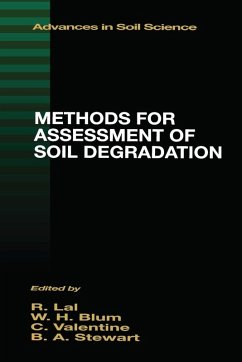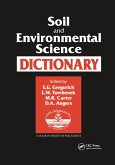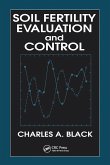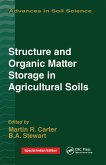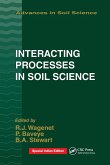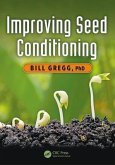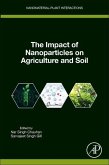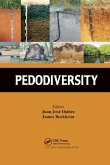- Broschiertes Buch
- Merkliste
- Auf die Merkliste
- Bewerten Bewerten
- Teilen
- Produkt teilen
- Produkterinnerung
- Produkterinnerung
This book explains predominant soil degradative processes for agricultural, urban, industrial and military land uses. It describes the methods of evaluating soil degradation by different processes and scaling procedures of data extrapolation across temporal and spatial scales.
Andere Kunden interessierten sich auch für
![Soil and Environmental Science Dictionary Soil and Environmental Science Dictionary]() Soil and Environmental Science Dictionary91,99 €
Soil and Environmental Science Dictionary91,99 €![Soil Fertility Evaluation and Control Soil Fertility Evaluation and Control]() Charles A BlackSoil Fertility Evaluation and Control86,99 €
Charles A BlackSoil Fertility Evaluation and Control86,99 €![Structure and Organic Matter Storage in Agricultural Soils Structure and Organic Matter Storage in Agricultural Soils]() M R CarterStructure and Organic Matter Storage in Agricultural Soils86,99 €
M R CarterStructure and Organic Matter Storage in Agricultural Soils86,99 €![Interacting Processes in Soil Science Interacting Processes in Soil Science]() R J WagenetInteracting Processes in Soil Science59,99 €
R J WagenetInteracting Processes in Soil Science59,99 €![Improving Seed Conditioning Improving Seed Conditioning]() Bill GreggImproving Seed Conditioning144,99 €
Bill GreggImproving Seed Conditioning144,99 €![The Impact of Nanoparticles on Agriculture and Soil The Impact of Nanoparticles on Agriculture and Soil]() The Impact of Nanoparticles on Agriculture and Soil201,99 €
The Impact of Nanoparticles on Agriculture and Soil201,99 €![Pedodiversity Pedodiversity]() Pedodiversity88,99 €
Pedodiversity88,99 €-
-
-
This book explains predominant soil degradative processes for agricultural, urban, industrial and military land uses. It describes the methods of evaluating soil degradation by different processes and scaling procedures of data extrapolation across temporal and spatial scales.
Hinweis: Dieser Artikel kann nur an eine deutsche Lieferadresse ausgeliefert werden.
Hinweis: Dieser Artikel kann nur an eine deutsche Lieferadresse ausgeliefert werden.
Produktdetails
- Produktdetails
- Verlag: CRC Press
- Seitenzahl: 576
- Erscheinungstermin: 2. Dezember 2019
- Englisch
- Abmessung: 234mm x 156mm x 29mm
- Gewicht: 794g
- ISBN-13: 9780367448097
- ISBN-10: 0367448092
- Artikelnr.: 58438909
- Herstellerkennzeichnung
- Libri GmbH
- Europaallee 1
- 36244 Bad Hersfeld
- gpsr@libri.de
- Verlag: CRC Press
- Seitenzahl: 576
- Erscheinungstermin: 2. Dezember 2019
- Englisch
- Abmessung: 234mm x 156mm x 29mm
- Gewicht: 794g
- ISBN-13: 9780367448097
- ISBN-10: 0367448092
- Artikelnr.: 58438909
- Herstellerkennzeichnung
- Libri GmbH
- Europaallee 1
- 36244 Bad Hersfeld
- gpsr@libri.de
Lal, Rattan; Blum, Winfried E. H.; Valentin, C.; Stewart, B.A.
1. Basic Concepts: Degradation, Resilience, and Rehabilitation 2. Soil
Quality and Sustainability 3. Methodologies for Assessment of Soil
Degradation Due to Water Erosion 4. Modeling Erosion by Water and Wind 5.
Soil Crusting 6. Hardsetting 7. Assessment, Prevention, and Rehabilitation
of Soil Structure Caused by Soil Surface Sealing, Crusting, and Compaction
8. Soil Compaction 9. The Characteristics of Soil Organic Matter Relative
to Nutrient Cycling 10. Soil Processes and Greenhouse Effect 11.
Acidification 12. Estimating Nutrient Balances in Agro-Ecosystems at
Different Spatial Scales 13. Salt Buildup as a Factor of Soil Degradation
14. Sodic Soils 15. Soil Pollution and Contamination 16. Acid Sulfate Soils
17. Long-Term Characterization: Monitoring and Modeling 18. Scaling and
Extrapolation of Soil Degradation Assessments 19. Applications of
Geographic Information Systems in Soil Degradation Assessments 20. Remote
Sensing Applications to Soil Degradation Assessments 21. Mapping Soil
Degradation 22. Revisiting the Glasod Methodology 23. Desertification
Assessment 24. Agronomic Impact of Soil Degradation 25. Methods of Economic
Assessment of On-Site and Off-Site Costs of Soil Degradation 26. The
On-Farm Economic Costs of Erosion 27. Methods for Assessing the Impacts of
Soil Degradation on Water Quality 28. Research and Development Priorities
Quality and Sustainability 3. Methodologies for Assessment of Soil
Degradation Due to Water Erosion 4. Modeling Erosion by Water and Wind 5.
Soil Crusting 6. Hardsetting 7. Assessment, Prevention, and Rehabilitation
of Soil Structure Caused by Soil Surface Sealing, Crusting, and Compaction
8. Soil Compaction 9. The Characteristics of Soil Organic Matter Relative
to Nutrient Cycling 10. Soil Processes and Greenhouse Effect 11.
Acidification 12. Estimating Nutrient Balances in Agro-Ecosystems at
Different Spatial Scales 13. Salt Buildup as a Factor of Soil Degradation
14. Sodic Soils 15. Soil Pollution and Contamination 16. Acid Sulfate Soils
17. Long-Term Characterization: Monitoring and Modeling 18. Scaling and
Extrapolation of Soil Degradation Assessments 19. Applications of
Geographic Information Systems in Soil Degradation Assessments 20. Remote
Sensing Applications to Soil Degradation Assessments 21. Mapping Soil
Degradation 22. Revisiting the Glasod Methodology 23. Desertification
Assessment 24. Agronomic Impact of Soil Degradation 25. Methods of Economic
Assessment of On-Site and Off-Site Costs of Soil Degradation 26. The
On-Farm Economic Costs of Erosion 27. Methods for Assessing the Impacts of
Soil Degradation on Water Quality 28. Research and Development Priorities
1. Basic Concepts: Degradation, Resilience, and Rehabilitation 2. Soil Quality and Sustainability 3. Methodologies for Assessment of Soil Degradation Due to Water Erosion 4. Modeling Erosion by Water and Wind 5. Soil Crusting 6. Hardsetting 7. Assessment, Prevention, and Rehabilitation of Soil Structure Caused by Soil Surface Sealing, Crusting, and Compaction 8. Soil Compaction 9. The Characteristics of Soil Organic Matter Relative to Nutrient Cycling 10. Soil Processes and Greenhouse Effect 11. Acidification 12. Estimating Nutrient Balances in Agro-Ecosystems at Different Spatial Scales 13. Salt Buildup as a Factor of Soil Degradation 14. Sodic Soils 15. Soil Pollution and Contamination 16. Acid Sulfate Soils 17. Long-Term Characterization: Monitoring and Modeling 18. Scaling and Extrapolation of Soil Degradation Assessments 19. Applications of Geographic Information Systems in Soil Degradation Assessments 20. Remote Sensing Applications to Soil Degradation Assessments 21. Mapping Soil Degradation 22. Revisiting the Glasod Methodology 23. Desertification Assessment 24. Agronomic Impact of Soil Degradation 25. Methods of Economic Assessment of On-Site and Off-Site Costs of Soil Degradation 26. The On-Farm Economic Costs of Erosion 27. Methods for Assessing the Impacts of Soil Degradation on Water Quality 28. Research and Development Priorities
1. Basic Concepts: Degradation, Resilience, and Rehabilitation 2. Soil
Quality and Sustainability 3. Methodologies for Assessment of Soil
Degradation Due to Water Erosion 4. Modeling Erosion by Water and Wind 5.
Soil Crusting 6. Hardsetting 7. Assessment, Prevention, and Rehabilitation
of Soil Structure Caused by Soil Surface Sealing, Crusting, and Compaction
8. Soil Compaction 9. The Characteristics of Soil Organic Matter Relative
to Nutrient Cycling 10. Soil Processes and Greenhouse Effect 11.
Acidification 12. Estimating Nutrient Balances in Agro-Ecosystems at
Different Spatial Scales 13. Salt Buildup as a Factor of Soil Degradation
14. Sodic Soils 15. Soil Pollution and Contamination 16. Acid Sulfate Soils
17. Long-Term Characterization: Monitoring and Modeling 18. Scaling and
Extrapolation of Soil Degradation Assessments 19. Applications of
Geographic Information Systems in Soil Degradation Assessments 20. Remote
Sensing Applications to Soil Degradation Assessments 21. Mapping Soil
Degradation 22. Revisiting the Glasod Methodology 23. Desertification
Assessment 24. Agronomic Impact of Soil Degradation 25. Methods of Economic
Assessment of On-Site and Off-Site Costs of Soil Degradation 26. The
On-Farm Economic Costs of Erosion 27. Methods for Assessing the Impacts of
Soil Degradation on Water Quality 28. Research and Development Priorities
Quality and Sustainability 3. Methodologies for Assessment of Soil
Degradation Due to Water Erosion 4. Modeling Erosion by Water and Wind 5.
Soil Crusting 6. Hardsetting 7. Assessment, Prevention, and Rehabilitation
of Soil Structure Caused by Soil Surface Sealing, Crusting, and Compaction
8. Soil Compaction 9. The Characteristics of Soil Organic Matter Relative
to Nutrient Cycling 10. Soil Processes and Greenhouse Effect 11.
Acidification 12. Estimating Nutrient Balances in Agro-Ecosystems at
Different Spatial Scales 13. Salt Buildup as a Factor of Soil Degradation
14. Sodic Soils 15. Soil Pollution and Contamination 16. Acid Sulfate Soils
17. Long-Term Characterization: Monitoring and Modeling 18. Scaling and
Extrapolation of Soil Degradation Assessments 19. Applications of
Geographic Information Systems in Soil Degradation Assessments 20. Remote
Sensing Applications to Soil Degradation Assessments 21. Mapping Soil
Degradation 22. Revisiting the Glasod Methodology 23. Desertification
Assessment 24. Agronomic Impact of Soil Degradation 25. Methods of Economic
Assessment of On-Site and Off-Site Costs of Soil Degradation 26. The
On-Farm Economic Costs of Erosion 27. Methods for Assessing the Impacts of
Soil Degradation on Water Quality 28. Research and Development Priorities
1. Basic Concepts: Degradation, Resilience, and Rehabilitation 2. Soil Quality and Sustainability 3. Methodologies for Assessment of Soil Degradation Due to Water Erosion 4. Modeling Erosion by Water and Wind 5. Soil Crusting 6. Hardsetting 7. Assessment, Prevention, and Rehabilitation of Soil Structure Caused by Soil Surface Sealing, Crusting, and Compaction 8. Soil Compaction 9. The Characteristics of Soil Organic Matter Relative to Nutrient Cycling 10. Soil Processes and Greenhouse Effect 11. Acidification 12. Estimating Nutrient Balances in Agro-Ecosystems at Different Spatial Scales 13. Salt Buildup as a Factor of Soil Degradation 14. Sodic Soils 15. Soil Pollution and Contamination 16. Acid Sulfate Soils 17. Long-Term Characterization: Monitoring and Modeling 18. Scaling and Extrapolation of Soil Degradation Assessments 19. Applications of Geographic Information Systems in Soil Degradation Assessments 20. Remote Sensing Applications to Soil Degradation Assessments 21. Mapping Soil Degradation 22. Revisiting the Glasod Methodology 23. Desertification Assessment 24. Agronomic Impact of Soil Degradation 25. Methods of Economic Assessment of On-Site and Off-Site Costs of Soil Degradation 26. The On-Farm Economic Costs of Erosion 27. Methods for Assessing the Impacts of Soil Degradation on Water Quality 28. Research and Development Priorities

